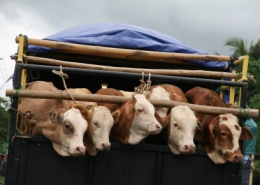Animal disease impact assessment in the Greater Mekong Sub-Region
Place: GMS • Dates: 2013 • Partner: FAO
Foot and mouth disease (FMD) is a persistent threat to livestock across the Greater Mekong Sub- Region. The disease is considered endemic to the region, and outbreaks continue despite concerted efforts by national governments and international agencies to control the spread of the disease through a variety of measures. Control measures could include prohibition of certain production practices and/or of raising particular species, but these may be important for sources of income for a large number of poor rural farming households. Measures put in place to control FMD may consequently have larger impacts on the lives of the rural poor than FMD itself. To target disease risk management policies in ways that are socially efficient, i.e. reconcile public health and livelihoods objectives requires support by rigorous quantitative assessment methods. This project is intended to provide such decision support to GMS livestock policy institutions, in the context of FMD and other high impact animal diseases.
Devising evidence-based responses to animal and human health risks that balance the interests of a wide variety of national and international stakeholders requires thorough analysis of epidemiological and economic information (past and present), development of scenarios of disease incidence, their likelihood of occurrence, the identification of critical control points and interventions, the costs and impacts of the latter, and, finally, negotiation between stakeholders at different levels, local, national, and regional/international.
This report describes an approach to systematically address the recurring need of national governments and the international community to respond to high impact disease threats using the incursion of FMD into the Greater Mekong Sub-Region, including Myanmar, Vietnam, Cambodia, and Lao PDR as cases from which to derive broader lessons. We first develop a conceptual framework to assess the multi-dimensional impacts of animal diseases, based on the characteristics and determinants of diseases and their impacts at different levels. We then focus on the measurement of impacts along the value chain and subsequently turn to methods for evaluating economywide impacts, both areas, where applications in the GMS have been limited. Value chain analysis offers detailed assessment of the directly affected livestock sub-sector itself, decomposing it from farm to consumer dining table and detailing the economic consequences of animal disease risk and its management. The economywide assessment looks across the entire economy at how disease risk affects the overall livestock sector, allied production and market activities, as well as consumers and stakeholders indirectly linked via spillover effects from outbreaks and policy responses. Taken together, supply chain and economywide assessment offer governments a comprehensive overview of the potential costs of high impact animal disease risk, as well as the benefits of effective risk management and outbreak response policies.
Most Recent Entries

California and China: Leadership for a Low Carbon Future

Roadmap on the Prospects for GMS National Scaling and GMS Regional Coordination of Agrifood Traceability Schemes





